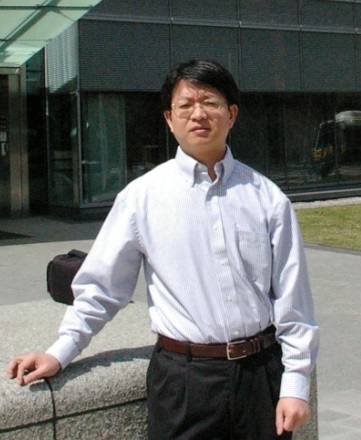| |

杨弋 教授 ------------------------------------------------------------------------------- 电话: (021) 6425-1311
传真: (021) 6425-1287
E-mail: yiyang@@ecust.edu.cn (去掉一个@) 生物化学与分子生物学专业:博士生导师/硕士生导师 药学专业:博士生导师/硕士生导师 微生物学:硕士导师 生物工程领域:工程硕士导师 ------------------------------------------------------------------------------- 【个人简介】 国家杰出青年基金获得者,生物反应器工程国家重点实验室副主任。1990年由湖北省黄冈中学考入清华大学生物科学与技术系,1995年获得学士学位。1999年获清华大学生物化学博士学位。毕业后赴美哈佛大学医学院进行金属硫蛋白的博士后研究工作。2002年转至波士顿大学医学院,从事一氧化氮自由基生物学,巯基组学及心血管疾病的研究。 2005年成为哈佛医学院及其附属的Brigham & Women’s 医院的生物化学副研究员及医学讲师。2006年回国并被聘为华东理工大`学药学院及国家生物反应器工程重点实验室特聘教授,从事合成生物学与光遗传学前沿技术发展与应用研究。2006年入选教育部新世纪优秀人才计划,2007年入选上海市浦江人才计划,2011年获上海市曙光学者称号,2014年入选上海市优秀学术带头人计划。2012年获国家杰出青年基金资助。2014年入选科技部中青年科技创新领军人才。现任中国生物化学与分子生物学会理事,中国生物化学与分子生物学会酶学专业委员会常务副主任,上海市细胞生物学学会副理事长。
【主要研究方向】 主要研究对象为利用合成生物技术与光遗传学技术控制与监测细胞内分子过程的前沿技术;癌症及代谢类疾病药理及药物筛选技术;蛋白质特异性标记、翻译后修饰的鉴定、与细胞内原位成像;蛋白质药物生产技术。在华东理工大学工作期间,建立了针对蛋白质二硫键与相邻巯基的荧光探针及原位与活细胞成像技术,揭示了线粒体对这些巯基修饰形式的调控作用,进而发展了高效表达药用蛋白的基因表达系统;发明了一系列特异性检测细胞内核心代谢物NADH、NADPH的基因编码荧光探针Frex、SoNar与iNaps,实现了在活体动物及活细胞各亚细胞结构中对细胞代谢的动态检测与成像,进一步利用这些探针发现了高效选择性的抗癌药物,揭示了其机制;发明了简单实用的LightON动物细胞光控基因表达系统,首次实现了光对哺乳动物组织内基因表达的控制。这些研究成果以主要作者身份发表在Nature Methods、Nature Protocols、Cell Metabolism、Cell Research、Angew. Chem.、PNAS, Nucleic Acids Research等一流杂志。所发明的前沿生物技术受到了许多国际同行的关注。目前已有全球有近600余实验室使用我们发展的各种前沿研究技术进行研究,其中哈佛大学、MIT、京都大学等科学家的应用我们技术的研究成果已经发表于Science、Cell Metabolism等一流期刊。
【代表性研究成果】 已在Nature Methods,Nature Protocols, Nature Communications, Cell Metabolism, Cell Systems, Cell Reports, Cell Research, PNAS, Angewandte Chemie, Embo J等刊物发表论文70余篇,授权国家发明专利8项,国际专利4项。代表性论著如下:
1.Hao X, Gu H, Chen C, Huang D, Zhao Y, Xie L, Zou Y, Shu HS, Zhang Y, He X, Lai X, Zhang X, Zhou BO, Zhang CC, Chen GQ, Yu Z*, Yang Y* and Zheng J*, Metabolic Imaging Reveals a Unique Preference of Symmetric Cell Division and Homing of Leukemia-Initiating Cells in an Endosteal Niche, Cell Metabolism 2019, 29, 950-965.2.Zou Y, Wang A, Shi M, Chen X, Liu R, Li T, Zhang C, Zhang Z, Zhu L, Ju Z, Loscalzo J, Yang Y* and Zhao Y*, Analysis of redox landscapes and dynamics in living cells and in vivo using genetically encoded fluorescent sensors, Nature Protocols 2018, 13, 2362-2386.3.Xu X, Du Z, Liu R, Li T, Zhao Y, Chen X* and Yang Y*, A Single-Component Optogenetic System Allows Stringent Switch of Gene Expression in Yeast Cells, ACS Synthetic Biology. 2018, 7, 2045-2053.4.Zhao Y*, Zhang Z, Zou Y and Yang Y*, Visualization of nicotine adenine dinucleotides redox homeostasis with genetically encoded fluorescent sensors, Antioxidants and Redox Signalling 2018,28, 213-229.5.Hu, Wang A, Huang L, Zou Y, Gu Y, Chen X, Zhao Y* and Yang Y*, Monitoring cellular redox state under hypoxia using a fluorescent sensor based on eel fluorescent protein, Free Radic Biol Med 2018, 120, 255-265.6.Tao R, Shi M, Zou Y, Cheng D, Wang Q, Liu R, Wang A, Zhu J, Deng L, Hu H, Chen X, Du J, Zhu W, Zhao Y* and Yang Y*, Multicoloured fluorescent indicators for live-cell and in vivo imaging of inorganic mercury dynamics, Free Radic Biol Med. 2018, 121, 26-37.7.Tao R, Zhao Y, Chu H, Wang A, Zhu J, Chen X, Zou Y, Shi M, Liu R, Su N, Du J, Zhou HM, Zhu L, Qian X, Liu H*, Loscalzo J and Yang Y*, Genetically encoded fluorescent sensors reveal dynamic regulation of NADPH metabolism, Nature Methods 2017, 14, 720-728.8.Zhao Y* & Yang Y*, Real-time and high-throughput analysis of mitochondrial metabolic states in living cells using genetically encoded NAD+/NADH sensors, Free Radic Biol Med, 2016, 100, 43-52.9.Chen X, Li T, Wang X, Du Z, Liu R, and Yang Y*. Synthetic dual-input mammalian genetic circuits enable tunable and stringent transcription control by chemical and light. Nucleic Acids Research, 2016, 44, 2677–2690.10.Zhao Y, Wang A, Zou Y, Su N, Loscalzo J, Yang Y*. In vivo monitoring of cellular energy metabolism using a highly responsive sensor for NAD+/NADH redox state. Nature Protocols 2016, 11, 1345-1359.11.Chen X, Li T, Liu R, Ma Z, Xu X, Zhang H, Xu J, Ouyang Q, Yang Y*. An extraordinary stringent and sensitive light switchable gene expression system for bacterial cells. Cell Research 2016, 26, 854–857.12.Zhao, Y., Hu, Q., Cheng, F., Su, N., Wang, A., Zou, Y., Hu, H., Chen, X., Zhou, H.M., Huang, X., Yang, K., Zhu, Q., Wang, X., Yi, J., Zhu, L., Qian, X., Chen, L., Tang, Y., Loscalzo, J., and Yang, Y*. SoNar, a Highly Responsive NAD(+)/NADH Sensor, Allows High-Throughput Metabolic Screening of Anti-tumor Agents. Cell Metabolism 2015, 21, 777-789.13.Zhao, Y., and Yang, Y. * Profiling metabolic states with genetically encoded fluorescent biosensors for NADH. Curr Opin Biotechnol 2015, 31, 86-92.14.Wang, X., Chen, X., and Yang, Y. * Spatiotemporal control of gene expression by a light-switchable transgene system. Nature Methods 2012, 9, 266-269.15.Huang, C., Yin, Q., Zhu, W. *, Yang, Y. *, Wang, X., Qian, X., and Xu, Y. * (2011). Highly Selective Fluorescent Probe for Vicinal-Dithiol-Containing Proteins and In Situ Imaging in Living Cells. Angew Chem Int Ed Engl 2011, 123, 7693-7698.16.Zhao, Y., Jin, J., Hu, Q., Zhou, H.M., Yi, J., Yu, Z., Xu, L., Wang, X., Yang, Y. *, and Loscalzo, J. Genetically Encoded Fluorescent Sensors for Intracellular NADH Detection. Cell Metabolism 2011, 14, 555-566.17.Yang, Y., Song, Y., and Loscalzo, J. Regulation of the protein disulfide proteome by mitochondria in mammalian cells. Proc Natl Acad Sci U S A 2007, 104, 10813-10817.18.Yang, Y., and Loscalzo, J. S-nitrosoprotein formation and localization in endothelial cells. Proc Natl Acad Sci U S A 2005, 102, 117-122.19.Yang, Y., Maret, W., and Vallee, B.L. Differential fluorescence labeling of cysteinyl clusters uncovers high tissue levels of thionein. Proc Natl Acad Sci U S A2001, 98, 5556-5559.
|
网页发布时间: 2019-06-18
|
|
|